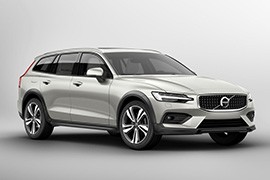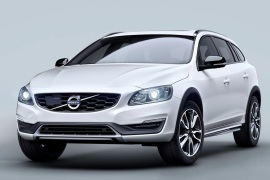VOLVO V60 Cross Country Models/Series Timeline, Specifications & Photos
First production year: 2015
Engines: Diesel, Gasoline
Body style: Wagon (station wagon, estate, combi, touring)
Just like the V60, upon which it is based, and the S60 sedan, the second generation of the Volvo V60 Cross Country is based on Volvo's Scalable Product Architecture (SPA) platform, which is used on every modern model developed after Geely took over the brand.
Essentially a V60 station wagon with increased ride height and standard all-wheel-drive, the V60 Cross Country wears a nameplate that is shared with other Volvos is a bit of a legend in its own right.
Based on a brand new platform, the second generation of the model is larger in almost every respect, while its design closely follows the same lines introduced by its bigger brothers in the 90 Series, but with an added dose of ruggedness from the carmaker's SUVs. Apart from the ride height, which has been increased by 60 mm compared to the regular V60, the most underlying Cross Country features are the black plastic additions to the wheel arches and the lower parts of the front and rear bumpers, which are bespoke to the model.
Volvo is mostly proud of the so-called “Thor's Hammer” LED headlamp design, all-new grille and the evolved Volvo Iron Mark badge, but those elements are shared with the regular V60 all other SPA-based modern Volvos.
The new V60 Cross Country is powered exclusively by four-cylinder engines, which deliver between 190 horsepower to 250 horsepower and can be mated either to an Aisin 8-speed automatic transmission or a 6-speed manual gearbox. As expected, an all-wheel-drive system in standard on all Cross Country models, including the V60.
In 2014, three years after the V60 introduction, Volvo unveiled the Cross Country version of their versatile mid-size car.
Volvo used the V-letter from "versatility," not from a wagon, even though most people thought the other way. For the Cross County version, that word genuinely fitted since it was a crossover. It had a higher ground clearance than its V60 brother, and that made it more capable when driving through the snow and muddy, unpaved roads. It also featured a standard all-wheel-drive system, which was only optional on the regular V60. Later on, the carmaker added an option for FWD only.
Volvo designers took their inspiration from shooting-brakes vehicles when they made the 2010 V60. The curved upper window line, sloped-down towards the D-pillar, confirmed that, but the grab-handles from the side didn't. At the front, the Cross Country version featured a new grille with a honeycomb pattern and a black patch for the adaptive cruise control radar. On the lower side of the bumper, Volvo installed an aluminum-look underbody protection. The same went for the back, where the carmaker flanked the rear shield with a pair of rectangular pipes.
Inside, it was the same V60 with its floating center stack, a unique Volvo feature. It sported a combination of metal, aluminum, and wood trim that made it look premium. The specific headrest designed to prevent a whiplash for the front occupants stood above the bucket seats at the front. In the back, there was room for three adults on the 40/20/40 split-folding rear bench. The trunk could hold 430 liters (15.2 cu-ft) with all the seats up, while with the rear seatback folded, it increased to 1,246 liters (44 cu-ft).
Under the hood, Volvo installed a choice of two gasoline and two turbo-diesel engines paired to either a six-speed manual or an eight-speed automatic.

